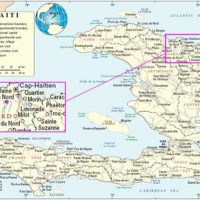Plaine Du Nord

The small municipality of Plaine-du-Nord, is located in L’Acul-du-Nord Arrondissement, in the Nord Department of Haiti. It is considered an essential part of Haitian history and is one of the centres of the vodun religion in the country.
The name of Plaine-du-Nord, this small town of 37,000 inhabitants is best known for the festival of Saint-Jacques generally celebrated with pomp on July 24 of each year. Tens of thousands of visitors come from all over the world to mark the event of this patron saint. Plaine-du-Nord and the image projected in the eyes of the visitors can be perceived in another way with its potentialities and its decadence begun for some time. Starting from the RN-1, Morne Rouge, the entrance to the city has a pretty gloomy aspect because the paved road that regulars have known until the mid-90s no longer exists.
Plaine du Nord, one of the eighteen communes of the Nord Department, is located 14 km from Cap Haitien. According to sources, the road is in bad shape between these two cities. It has a district and four Communal Sections. Its inhabitants bear the name of Campinordais. In 1998, the population of the Plaine du Nord Commune was estimated at 33 662 inhabitants and projections place it at nearly 37,000 in 2004. The town center has an area of 3.12 km2 (1.2 Square miles) and a density of 3,572 people per km2 (9,288 people per square mile).
Plaine-du-Nord is the historical site where the battle between Haiti’s French colonizers and African slaves who worked in plantations began. This led to Haiti’s independence from its colonizers and the freedom of slaves who became the very first official Haitians.
Education: The Ministry of National Education of Youth and Sports is not represented in the Commune of Plaine du Nord. Ten Kindergarten, several primary schools including six public, numerous private, and three Congregational; and seven secondary schools have been inventoried in the Northern Plain. In addition, there are nine vocational schools and three literacy centers. There is no university or other higher school in the commune.
Health: The Ministry of Public Health is not represented in the Commune. There are four clinics, and a Radiodiagnostic center complete with a team of doctors, dentists, nurses, auxiliaries, certified matrons and laboratory technicians.
Utilities: The municipality has two rivers, five springs, and a lagoon. In addition, 15 single boreholes, ten artesian wells, twenty valves, and 150 pumps for domestic use were identified. Haiti’s electricity is the institution that distributes electric power in the city, to the Communal Sections of Morne Rouge and Vaudreuil. Thanks to an electric motor, this current is provided twice a week.
Security: With regard to the Administrative and Judicial Infrastructures, the Municipality has a Court of Peace, a Commissariat and a registry office. There is no Prison but, a custody room.
Religion: With regard to Religion, nearly forty nine temples have been listed in the commune. The number of churches and chapels for denominations such as Episcopal, Baptist, Adventist, Pentecostal, Jehovah’s Witness does not exceed four; the Catholic churches (13 in total) represent the confession best represented (in number of temples) in the Commune.
Organizations: Three Popular Organizations, two easant Groups, a Women’s Group and three NGOs form the political institutions and other Organizations of the commune.
Communication: At the time of the inventory, the town had no telephone. On the other hand, it has a postal service that works somehow.
Leisure: Apart from the sports practiced in the town such as: football (soccer), basketball, volleyball, athletics, tennis and karate, thirty-three (33) gaguères complete the meager places of entertainment and entertainment. In the field of Cultural Heritages, there is also the existence of a colonial site (Bois Caiman) located in Morne Rouge. This site is reminiscent of the slave revolt that took place on the night of 13 to 14 August 1793 under the direction of Boukman and another natural site (Grotte de Saint Jacques) located in Grand Boucan. The latter is a place of pilgrimage and vodonesque sacrifice. Each year, the municipality sees big events that sometimes last up to twenty two days.
Pilgrimage Festival: The municipality is currently considered as the country’s Pilgrimage Festival capital, which attracts thousands of worshippers and foreign visitors yearly. One of Plain-du-Nord’s biggest, most important festivals is the Saint Jacques Fiesta, which is celebrated every 25th of July. It is then followed by the Saint Anne celebration a day after. Pilgrims usually stay for 15 days in the municipality during these festivities in order to offer food to the less fortunate, light candles, and donate money to the local churches.
Religion: Aside from the different annual Pilgrimage Festivals, Plaine-du-Nord is also known for its inhabitants’ active practice of vodun. The days’ Tuesday and Thursday mark the occurrence of voodoo rituals in municipality’s famous muddy basin also referred to as Bassin Saint Jacques. The sacred pool of Sucry is also another popular site of voodoo worship,especially during the Sucry voodoo pilgrimage that involves two long weeks of celebration and worship. Baptisms, chants, dances, and sacrifices are the usual happenings during this annual pilgrimage.

